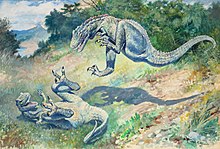A graphic novel is a long-form work of sequential art. The term graphic novel is often applied broadly, including fiction, non-fiction, and anthologized work, though this practice is highly contested by comics scholars and industry professionals. It is, at least in the United States, typically distinct from the term comic book, which is generally used for comics periodicals and trade paperbacks.
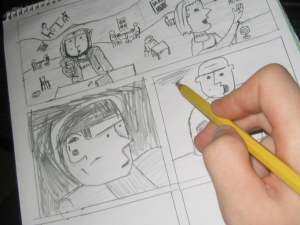
In comics studies, sequential art is a term proposed by comics artist Will Eisner to describe art forms that use images deployed in a specific order for the purpose of graphic storytelling or conveying information. The best-known example of sequential art is comics.

Scott McCloud is an American cartoonist and comics theorist. He is best known for his non-fiction books about comics: Understanding Comics (1993), Reinventing Comics (2000), and Making Comics (2006), all of which also use the medium of comics.

Othniel Charles Marsh was an American professor of paleontology at Yale College and president of the National Academy of Sciences. He was one of the preeminent scientists in the field of paleontology. Among his legacies are the discovery or description of dozens of new species and theories on the origins of birds.
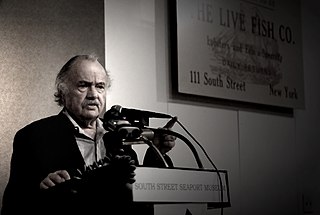
Ronald Joseph Goulart was an American popular culture historian and mystery, fantasy and science fiction author.

Edward Drinker Cope was an American zoologist, paleontologist, comparative anatomist, herpetologist, and ichthyologist. Born to a wealthy Quaker family, he distinguished himself as a child prodigy interested in science, publishing his first scientific paper at the age of 19. Though his father tried to raise Cope as a gentleman farmer, he eventually acquiesced to his son's scientific aspirations.

Charles Hazelius Sternberg was an American fossil collector and paleontologist. He was active in both fields from 1876 to 1928, and collected fossils for Edward Drinker Cope and Othniel C. Marsh, and for the British Museum, the San Diego Natural History Museum and other museums.

Alexander Cannon is an American cartoonist, known for his work on books such as Top 10, Smax and Kaijumax.

Agathaumas is a dubious genus of a large ceratopsid dinosaur that lived in Wyoming during the Late Cretaceous. The name comes from Ancient Greek: αγαν - 'much' and θαυμα - 'wonder'. It is estimated to have been 15 metres (49 ft) long and weighed 17.5 tonnes, and was seen as the largest land animal known at the time of its discovery.

Weird West is a term used for the hybrid genres of fantasy Western, horror Western and science fiction Western. The term originated with DC's Weird Western Tales in 1972, but the idea is older as the genres have been blended since the 1930s, possibly earlier, in B-movie Westerns, comic books, movie serials and pulp magazines. Individually, the hybrid genres combine elements of the Western genre with those of fantasy, horror and science fiction respectively.

Joshua Ortega is an American author and journalist best known for his novel Frequencies, as well as his comic book and graphic novel work on entertainment properties such as Star Wars, Spider-Man, Batman, Star Trek, The Escapist, and The Necromancer.
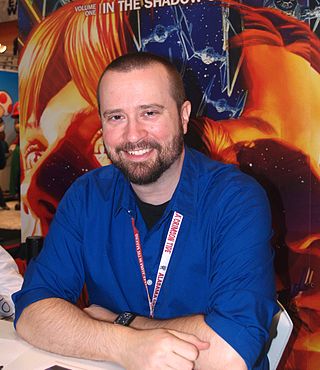
Dan Jolley is an American novelist and comic book writer. His comics work includes DC Comics' Firestorm and Graphic Universe's Twisted Journeys, a series of interactive fiction or gamebooks in graphic novel form, and his novel work includes the young-adult science fiction espionage series Alex Unlimited along with his international best selling novel, The Gray Widow's Walk, which is his first book in the Gray Widow trilogy that he publishes through Seventh Star Press. He created the comic book character Jason Rusch with ChrisCross.

Tyrannosaurus rex is unique among dinosaurs in its place in modern culture; paleontologist Robert Bakker has called it "the most popular dinosaur among people of all ages, all cultures, and all nationalities". Paleontologists Mark Norell and Lowell Dingus have likewise called it "the most famous dinosaur of all times." Paleoartist Gregory S. Paul has called it "the theropod. [...] This is the public's favorite dinosaur [...] Even the formations it is found in have fantastic names like Hell Creek and Lance." Other paleontologists agree with that and note that whenever a museum erects a new skeleton or bring in an animatronic model, visitor numbers go up. "Jurassic Park and King Kong would not have been the same without it." In the public mind, T. rex sets the standard of what a dinosaur should be. Science writer Riley Black similarly states, "In all of prehistory, there is no animal that commands our attention quite like Tyrannosaurus rex, the tyrant lizard king. Since the time this dinosaur was officially named in 1905, the enormous carnivore has stood as the ultimate dinosaur."
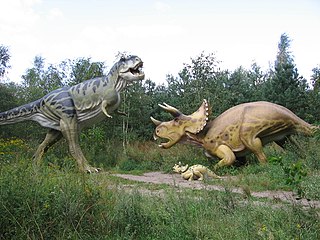
Cultural depictions of dinosaurs have been numerous since the word dinosaur was coined in 1842. The non-avian dinosaurs featured in books, films, television programs, artwork, and other media have been used for both education and entertainment. The depictions range from the realistic, as in the television documentaries from the 1990s into the first decades of the 21st century, or the fantastic, as in the monster movies of the 1950s and 1960s.

Jim Ottaviani is an American writer who is the author of several comic books about the history of science. His best-known work, Two-Fisted Science: Stories About Scientists, features biographical stories about Galileo Galilei, Isaac Newton, Niels Bohr, and several stories about physicist Richard Feynman. He is also a librarian and has worked as a nuclear engineer.

Edmontosaurus annectens, often colloquially and historically known as the Anatosaurus, is a species of flat-headed saurolophine hadrosaurid dinosaur from the late Maastrichtian age at the very end of the Cretaceous period, in what is now western North America. Remains of E. annectens have been preserved in the Frenchman, Hell Creek, and Lance Formations. All of these formations are dated to the late Maastrichtian age of the Late Cretaceous period, which represents the last three million years before the extinction of the dinosaurs. E. annectens is also found in the Laramie Formation and magnetostratigraphy suggests an age of 69-68 Ma for the Laramie Formation. Edmontosaurus annectens is known from numerous specimens, including at least twenty partial to complete skulls, discovered in the U.S. states of Montana, South Dakota, North Dakota, Wyoming, and Colorado, as well as the Canadian province of Saskatchewan. It had an extremely long and low skull and was quite a large animal, growing up to approximately 12 metres (39 ft) in length and 5.6 metric tons in average asymptotic body mass, although it could have been even larger. E. annectens exhibits one of the most striking examples of the "duckbill" snout that is common to hadrosaurs. It has a long taxonomic history and specimens have at times been classified as Diclonius, Trachodon, Hadrosaurus, Claosaurus, Thespesius, Anatosaurus, and Anatotitan before all being grouped together in Edmontosaurus

The Bone Wars, also known as the Great Dinosaur Rush, was a period of intense and ruthlessly competitive fossil hunting and discovery during the Gilded Age of American history, marked by a heated rivalry between Edward Drinker Cope and Othniel Charles Marsh. Each of the two paleontologists used underhanded methods to try to outdo the other in the field, resorting to bribery, theft, and the destruction of bones. Each scientist also sought to ruin his rival's reputation and cut off his funding, using attacks in scientific publications.

Paleontology in the United States refers to paleontological research occurring within or conducted by people from the United States. Paleontologists have found that at the start of the Paleozoic era, what is now "North" America was actually in the southern hemisphere. Marine life flourished in the country's many seas. Later the seas were largely replaced by swamps, home to amphibians and early reptiles. When the continents had assembled into Pangaea drier conditions prevailed. The evolutionary precursors to mammals dominated the country until a mass extinction event ended their reign.

The history of paleontology in the United States refers to the developments and discoveries regarding fossils found within or by people from the United States of America. Local paleontology began informally with Native Americans, who have been familiar with fossils for thousands of years. They both told myths about them and applied them to practical purposes. African slaves also contributed their knowledge; the first reasonably accurate recorded identification of vertebrate fossils in the new world was made by slaves on a South Carolina plantation who recognized the elephant affinities of mammoth molars uncovered there in 1725. The first major fossil discovery to attract the attention of formally trained scientists were the Ice Age fossils of Kentucky's Big Bone Lick. These fossils were studied by eminent intellectuals like France's George Cuvier and local statesmen and frontiersman like Daniel Boone, Benjamin Franklin, William Henry Harrison, Thomas Jefferson, and George Washington. By the end of the 18th century possible dinosaur fossils had already been found.

Dragon Teeth is a novel by Michael Crichton, the eighteenth under his own name and third to be published after his death, written in 1974 and published on May 23, 2017. A historical fiction forerunner to Jurassic Park, the novel is set in the American West in 1876 during the Bone Wars, a period of fervent competition for fossil hunting between two real-life paleontologists noted for their intense rivalry, Othniel Charles Marsh and Edward Drinker Cope. The plot follows the fictional protagonist William Johnson, a Yale student who works during the summer alternately for the two paleontologists.



